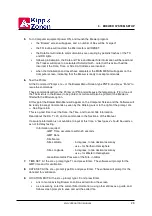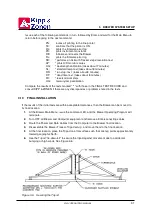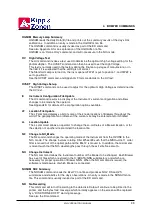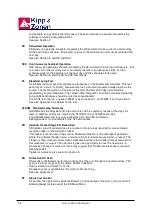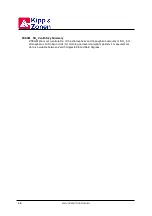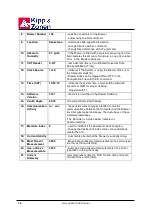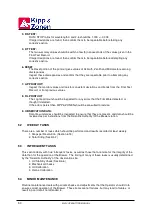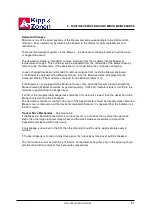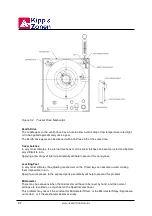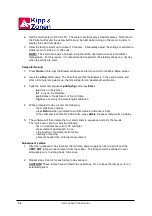
16-10-200716-10-2007
MKIV OPERATOR’S MANUAL
41
RS
Slit Mask Run/Stop Test
A malfunction in the slit mask motor circuit or in the slit mask itself can result in improper
counting and consequently incorrect data. The RS test produces a report on the operation of
the Slit Mask Motor by taking measurements in the “Running” and in the “Stopped” modes of
the Slit Mask Motor.
The RS command is normally executed as part of the ED routine and the test results are
recorded in the RSOAVG file.
For the RS test, FW#1 is set to position 1, FW#2 is set to position 0 and the iris is open.
RS values consistently outside the range of 0.997 to 1.003 for slitmask positions 2 to 6
should be investigated.
See Appendix F for an explanation of the RS test, and Appendix A for the RSOAVG.nnn and
RSNAVG.nnn files.
SA
Solar Angle Printout
SA will generate a printout of GMT vs. air mass, solar zenith angle and lunar zenith angle for
the day and location currently in use. Printouts for pasts and future dates, or different
locations are possible by simply changing the Brewer system date and/or location.
SC
Direct Sun Scan
Normally a factory or pre-calibration test, the SC determines the correct operating position of
the diffraction grating.
See also Appendix F.
SE
Schedule Edit
SE is used to create or modify Brewer operating schedules, which are stored as “.SKD” files
in the Brewer directory. Brewer schedules consist of two columns of data - a solar zenith
angle, and a string of commands. The string of commands is executed at the corresponding
solar zenith angle. The SA command is useful for converting GMT to solar angle.
See Section 8 for more information on designing schedules.
See also the SK and SKC commands.
SH
Slit Mask (shutter) Motor Timing Test
Normally a factory test, the SH command is used to determine the timing constant used in
the control of the slit mask motor.
See Appendix F.
SI
Solar Siting
Brewer observations using the solar disc as the radiation source require that the Zenith Prism
of the instrument be pointed very accurately toward the sun. The SI command is used in the
initial set-up of the instrument and for subsequent checking of pointing accuracy.
After the date, time, and station co-ordinates have been set accurately, a set of four controls
on the front of the instrument are used to introduce ‘Horizon’ and ‘North’ corrections which
compensate for any offsets that may occur. These corrections are saved and used by the
software in future pointing calculations.
See also Section 0.
SIM Lunar Siting
Brewer observations using the lunar disc as the radiation source require that the input
window of the instrument be pointed very accurately toward the moon. (Normally the SI
command is used if at all possible, as a siting using the moon is a much more difficult task
than a siting using the sun.) The SIM command is used in the initial set-up of the instrument
and for subsequent checking of pointing accuracy in the event that the SI command cannot
be used.
After the date, time, and station co-ordinates have been set accurately, a set of four controls
on the front of the instrument are used to introduce ‘Horizon’ and ‘North’ corrections which
4. BREWER COMMANDS
Summary of Contents for BREWER MK IV
Page 1: ...INSTRUCTION MANUAL OM BA C230 B Mk IV...
Page 2: ...REVISION HISTORY REV DESCRIPTION DCN DATE APPD B Update 99 16 12 C Update 07 16 10...
Page 3: ...ii...
Page 5: ...2...
Page 7: ...4...
Page 25: ...MKIV OPERATOR S MANUAL 22...
Page 57: ...MKIV OPERATOR S MANUAL 54...
Page 61: ...MKIV OPERATOR S MANUAL 58...
Page 81: ...MKIV OPERATOR S MANUAL 78...
Page 91: ...MKIV OPERATOR S MANUAL 88...
Page 93: ...MKIV OPERATOR S MANUAL 90...
Page 127: ...MKIV OPERATOR S MANUAL 124...
Page 133: ...MKIV OPERATOR S MANUAL 130...
Page 135: ...MKIV OPERATOR S MANUAL 132...



